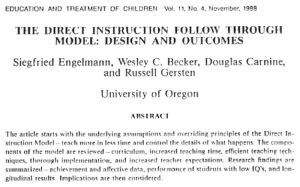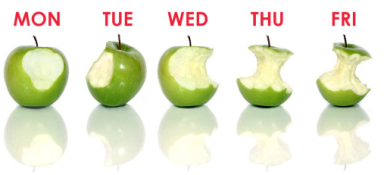This year I radically shifted my instructional focus. I made it a goal for all my lessons to be approximately 85% review of previous content, with only 10-15% of each lesson being new content.
The 85% review takes many forms – lesson starters, homework checks, interleaved low-stakes quizzes – but has had profound and far-reaching impacts in all areas of my instruction. I will detail three major effects shortly, but first, where did this 85:15 ratio originate?
Siegfried Engelmann

Siegfried “Zig” Engelmann started as a former marketing director for an advertising agency interested in how many repetitions it took for a child to learn something. After searching and not finding any available research on the topic, Engelmann ran some studies on his own with small groups of students and his two sons. Engelmann video-recorded these sessions and tried to persuade universities to hire him after showing how he successfully taught 5 year-old students algebra. Only the University of Illinois was willing to hire Engelmann.
Engelmann would go on to develop Direct Instruction System for Teaching Arithmetic and Reading (DISTAR) in the 1960s, which was characterized by carefully sequenced curriculum, teacher scripts, unison choral responses, and regular assessments. Note that this Direct Instruction (capital D, capital I) is unique from the teacher effects pattern outlined by Rosenshine in the 1980s, although both share many similar characteristics.

Engelmann’s (1999) Student Program Alignment and Teaching to Mastery paper identified the 85:15 split as a key component of an effective mastery learning program. In the paper, Engelmann argued that teachers should gradually develop student mastery in all lessons by presenting material in small, incremental steps.
“A program design that supports mastery does not present great amounts of new information and skill training in each lesson. Rather, work is distributed so new parts in a lesson account for only 10–15 percent of the total lesson. The rest of the lesson firms and reviews material and skills presented earlier in the program.”
Engelmann noted that the emphasis on mastery and review is in contrast to the typical curriculum characterized by topical or thematic units with little if any connections made between lessons or units.
“Students will work on a particular unit for a few days and then it will be replaced by another unit that is not closely related to the first and that does not require application of the same skills and knowledge.”
While I was skeptical of devoting so little time to new content, my doubts disappeared after discovering that Engelmann’s Direct Instruction – with its incremental steps and heavy emphasis on review – was shown to be the most effective form of instruction in Project Follow Through – the largest and most expensive educational research student ever conducted by the U.S. federal government.

To make the switch to an 85:15 split, first I had to re-examine how my current curriculum was designed and sequenced.
Benefit 1: Improved Unit/Lesson Planning
Prior to my adjustment, I found myself in an exhausting cycle. I would typically spend more than half of lessons leading students through loads of new, cognitively-demanding content, and would then set independent work only to find that students were already mentally depleted.
I would then end with an exit slip with one or two more similar items, but this would usually confirm my suspicion that the majority of students were confused. So I would go back to the drawing board, re-plan and re-teach the concept the next day, all the while worried that I was running out of time before the next, upcoming high-stakes quiz.

As soon as I committed to the 85:15 split, I realized I needed to design my lessons differently – the new content had to be in smaller, more manageable chunks. For example, rather than using multiple visual representations of fractions in a single lesson, I would spread the representations out and have students develop familiarity with each.
“Teachers cannot teach to mastery without a program design that supports the approach. Teaching to mastery is built upon effective student and program alignment. The program assumes that nothing is taught in one lesson. Instead, new concepts and skills are presented in two or three consecutive lessons to provide students with enough exposure to new material that they are able to use it in applications.”
Engelmann’s (1999) Student Program Alignment and Teaching to Mastery
Immediately, students experienced greater success and I found myself devoting more of my planning time to the sequencing and delivery of new content instead of home-brewing massive reteach lessons. I also found myself spending a great deal more time thinking of effective ways of questioning students and checking comprehension.
By shifting to 85% review, I also realized I had to be very intentional about the content of my homework (always review) and what items to routinely include on low-stakes assessments. My perspective on lesson planning expanded so that I was always looking for links and connections, rather than scrambling to re-adjust and re-teach on a day-to-day basis.
Benefit 2: Students Do More High-Quality Work
During observations, colleagues would frequently note that I was “doing more work than the students.” I knew this was true, but I was not confident in the quality of my students’ independent work – I felt I had no other choice but to take over the heavy lifting.
What I’ve realized now is that I was spending an unsustainable and inefficient amount of time and energy leading students through cognitively-demanding new content for the majority of every lesson. I was not effectively managing my students’ cognitive load. I needed to chunk the new content more strategically and provide additional practice and review.

As soon as I limited the amount of new content taught in each lesson and increased time spent revisiting prior content, I was able to give students more demanding and rigorous pair and independent work. This in turn allowed me to spend more time circulating, noticing common errors, and providing further assistance to individual students.
In summary, by shifting the emphasis to revisiting prior content with only small and carefully sequenced doses of new content, the quality and quantity of student work immediately improved. This had the additional positive benefit of building student self-confidence and self-reliance in completing high-quality, independent work.
Benefit 3: More Retrieval = Less Reteaching
I used to think of assessments as time-consuming and stressful requirements that would result in stacks of papers and grading. Once I learned about low-stakes assessments and whole-group feedback, I now see assessments as one of the most underutilized instructional techniques a teacher has at their disposal.
Essentially, I plan 2-3 low-stakes assessments per week, each with 4-6 questions that are interleaved with questions from the most recent lesson and from previous units. I include deliberately-chosen questions that give students multiple “at-bats” with more difficult concepts. This eliminates the need for extensive reteach lessons later in terms. I either rapidly mark the quizzes in front of the students or have them self-correct using the document camera. Clear and concise feedback is vital.

These low-stakes assessments are effective because they activate retrieval which reconstructs the entire neural pathway to stored information. Efrat Furst breaks down why teachers should incorporate routine, effortful, and properly-supported retrieval in her post, Retrieval Practice: Paving Pathways in the Memory Maze:
“Retrieval is highly effective as a method of practice, it has strong continually-growing body of evidence, and most importantly – it can be applied in any classroom to enhance the learning of all students, to close gaps and supply students with effective learning-tools for the rest of their journey.”

Furst also notes the importance of framing these assessments as routine, low-stakes learning activities that emphasize the correcting of mistakes.
“The way we address the activity (e.g. quiz vs. review), how we frame it (e.g. surprise quiz vs. morning review routine), the stakes (high vs. low or none), and how much room we leave for making mistakes and correcting them are essential factors.”
By including routine retrieval in lessons, students’ working memory is freed up as increasing amounts of knowledge become automatic and easily accessible. This allows me to increase the rigor of students’ independent work as an increasing amount is devoted to deepening and connecting prior knowledge.
Takeaways
I hope to have shown how shifting my lessons to 85% review and 15% new content has completely shifted how I plan, teach, and assess in the classroom. No longer are lessons at the end of the week or term wasted because every single lesson is a valuable opportunity to further reinforce and build students’ content knowledge.
Most beneficial, I’ve found that my newfound emphasis on review is developing curriculum coherence as concepts are now being deeply woven together on a daily basis.
How do you incorporate review throughout your lessons?
A really useful article, thanks. Triggered lots of thoughts for me. I think that this 85:15 split is exactly what good teaching looks like. I think that a lot of teachers come to this conclusion not by reading the research around this, or being aware of Engelmann’s work, but by realising through a process of trial-and-error that this ratio split actually works – in fact, it may even be that this approach is invisible to them, that they are not cognitively aware that they are doing it, but still they do it because it feels intuitively right. So thank you for making the intuitive explicit – always a good thing to do in itself, but here it helps too because it gives a justification for why we should take this approach, a permission-giver if you like.
LikeLike
Yes, intuitively right. I have always made efforts to connect my lessons as I believe a bigger picture of interconnected concepts will serve well to answer the ‘why’ for student learning. I find the 85:15 ratio and how it affects the lessons and assessments fascinating. Would love to read more on this.
LikeLike
Reblogged this on Teaching is About Learning and commented:
Cool article. It’s nice to see this. It confirms things I have been thinking for a while now. I would love to have some in-depth discussion about how to rework lessons so that they can be done using this approach.
LikeLike